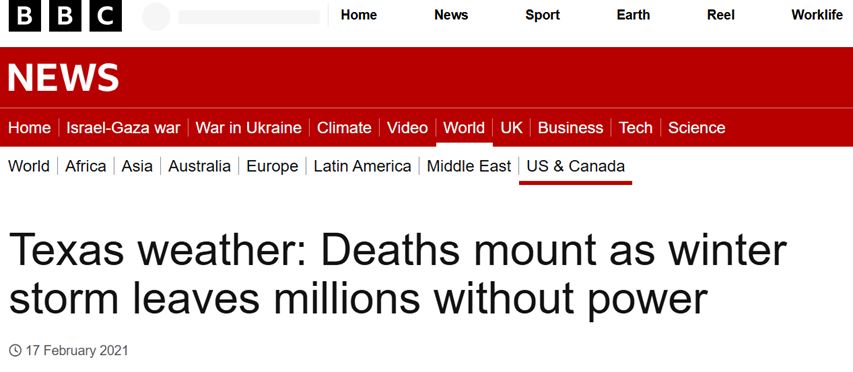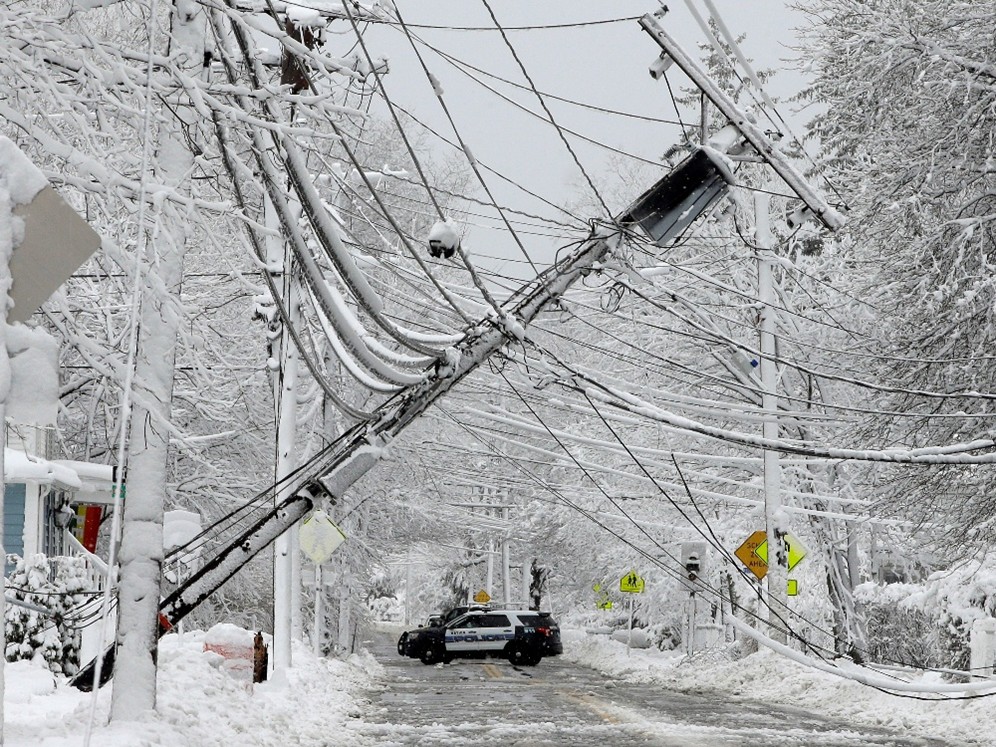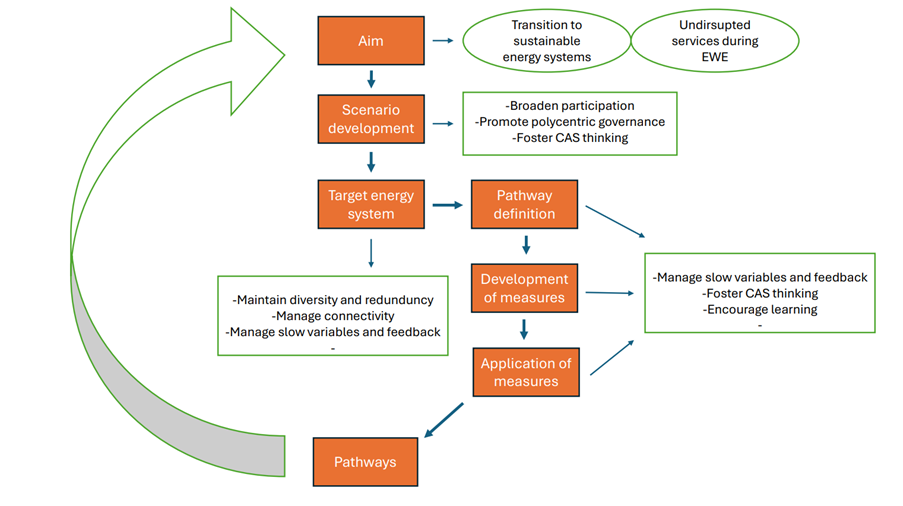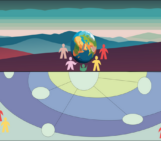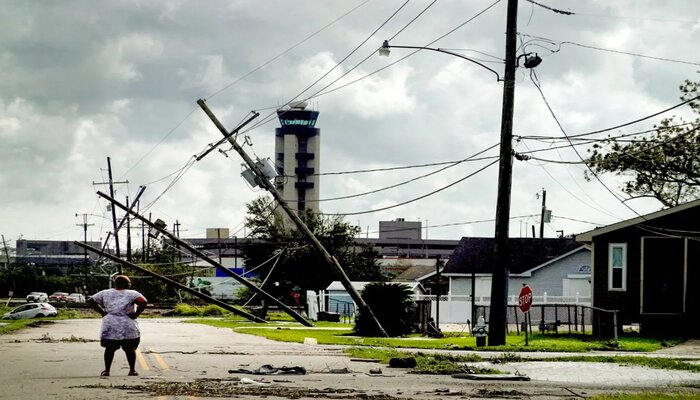
Have you ever wondered what energy resilience means and how we can prepare for the future while facing extreme weather events? In this week’s blog, PhD Student Spilios Iliopoulos from the Division of Environmental Technology and Management at Linköping University, shares his thoughts about energy resilience and the important role of having in place holistic frameworks, whilst facing extreme weather events and other challenges in the future.

Spilios Iliopoulos- PhD student at the Division of Environmental Technology and Management, Department of Management and Engineering (IEI) at Linköping University in Sweden. You can reach out to Spilios via e-mail and on LinkedIn.
While writing this short article, the memories (and trauma) from the second winter of the COVID-19 pandemic still feel fresh. In February 2021, locked down in an apartment in Athens, Greece, I did not pay much attention to what was unfolding two blocks away from me, let alone on the other side of the world, when news headlines like the ones below appeared in my news feed:
The above two statements reveal two main issues around the intersection of the topics of climate change, extreme weather events and energy. First, the misconception that storms like Uri that hit Texas are rare events not likely to reappear within our lifetimes. The concept of “once in a lifetime storm,” also referred to as “100-year storm” or “100-year flood,” is a probabilistic approach to define the return period of a natural hazard. But the example of Texas experiencing 500-year flood events for three years in a row comes to debunk this widely used return period approach, signifying that climate change increases the frequency as well as the intensity of such events (GFDRR, 2017). So, four years later, Texas experienced another “once in a lifetime” winter storm:
The second issue relates to how vulnerable our critical energy infrastructure is not only to events related to a rapidly shifting geopolitical landscape, but also to the enhanced impacts of climate change. Natural hazards and especially storm-related extreme weather events (EWE) have been the main cause of the most severe blackouts globally from 1965 to 2011 (Göteman et al., 2025).
This calls for a renewed approach to energy systems resilience within a changing and complex landscape for energy security. In the case of storm Uri, the increased and unforeseen power demand coupled with low supply due to disruptions in electricity generation, particularly from natural gas and the extreme cold weather led to intentional rolling blackouts and power outages to prevent the worst-case scenario of a prolonged, state-wide outage (Potts et al., 2024). However, in some cases, power outages persisted, resulting in cascading effects that threatened livelihoods and contributed to the increased number of casualties related to the storm.
What is resilience and energy systems’ resilience
But to begin with, what does the word resilience mean beyond a “flirty” donor-appeasing buzzword in international development projects and business organisations? Moreover, what does energy system resilience imply in relation to extreme weather events and in other areas?
Resilience as a concept is used today to describe communities, infrastructure and even individuals in a vast array of disciplines from urban planning to climate change adaptation and disaster management. Looking for its roots, resilience in its modern conception emerged from the fields of psychology and ecology and in the case of systems, from a socio-ecological systems perspective, defined as the capacity of a system to absorb a disturbance and to re-organise its components in a way that it retains functions and identity (Holling, 1973; Walker et al., 2004; Folke et al., 2010).
Socio-ecological resilience in contrast to the concept of engineering resilience establishes that there is not a single equilibrium state that can return to retain system functions, but rather adapts and transforms in the face of disturbances. Thus, taking a step back, we should ask ourselves two important questions: “what” is resilient and “to what” is it resilient. The “what” refers to the system and its components, while the “to what” concerns the disturbance, as in the different types of extreme weather events, whether it is snowstorms like Uri, wildfires, hurricanes or floods.
To answer those questions for the case of energy systems, one must begin by defining them. Therefore, energy systems can be seen beyond solely technical systems comprising of infrastructures and physical components for production, transmission, distribution and demand (Gonçalves et al., 2024; Andersson et al., 2024). If one approaches energy systems from a socio-technical system perspective they also consist of more interconnected elements beyond infrastructure, such as policy, organisations and other actors including the civil society (Geels, 2004) This points towards of co-evolution between technology, society and a high degree of interaction between their various elements (Wiese, 2016).
By incorporating resilience thinking and perceiving energy systems as complex adaptive socio-technical systems, each component of the system, physical or nonphysical, demonstrates different vulnerabilities to different events (International Energy Agency, 2022). The impacts of climate change and extreme weather events ought to be studied in relation to the ongoing energy transition for mitigating climate change and meeting the Paris Agreement targets (Forsberg et al., 2024). This transition occurs by shifting towards renewables for electricity production, such as wind power, solar power, hydropower or geothermal sources, as well as the replacement of technologies that use fossil fuels, a process also known as electrification. Although largely energy resilience tends to become a synonym for energy security, particularly related to uninterrupted supply in the face of different disruptions (Wiese, 2016), a risk-only based approach tends to leave out important dimensions, especially those related to sustainability (Azzuni & Breyer, 2018).
Towards a unifying resilience thinking framework —not a one-size-fits-all approach
Resilience is a highly contextual and dynamic concept with an under-looked temporal dimension. Expanding on the latter, the temporal dimension- something that is resilient at some point in time might reduce resilience in the future— is characterised and influenced by a high degree of complexity and uncertainty. This is because system components, as well as elements in the system’s environment out of its sphere of control interact in nonlinear and complex ways.
And here is where things become somewhat even more complex. The latter highlights the importance of creating context and event-specific frameworks for measuring energy systems’ resilience (Potts et al., 2024). However, resilience thinking does not come about in isolation; it rather requires a holistic and transdisciplinary approach. An overreliance on event-specific frameworks for unpacking energy resilience might inhibit the peril of creating path dependencies that reduce the overall resilience of the system over time. Thus, it is important to use holistic-approach frameworks like the one presented by Wiese et al (2016) based on the seven resilience principles by Stockholm Resilience Centre. These are necessary to consider the overall system and the multiplicity of disturbances beyond a single extreme weather event.
The above framework, as demonstrated in Fig. 5 builds upon seven main principles that are of high relevance to addressing various types of disturbances on systems, including several types of extreme weather events and as demonstrated by scholars like Andersson et al. (2024), it can also be applied in the context of energy systems.
The principle of diversity and redundancy points towards the need for complementing components that come into play for substituting the loss of others. A great example of this is battery storage that can contribute to reserve electricity in the case of power outages caused by a storm. Connectivity can be advanced, for instance, through more connections with the environment of the system, in the case of power systems with infrastructure beyond the local level. However, increased connectivity can also lead to path dependencies that can reduce the system’s overall resilience in relation to other events. This can be depicted as an example of the European energy price crisis in 2022.
Managing slow and fast variables is vital and comes with significant challenges. As energy transitions accelerate, electrification becomes a priority for our energy systems (Andersson et al., 2024; Panteli & Mancarella, 2015). At the same time, this process adds pressure to the distribution parts of the electricity system because of increased demand and a slow expansion (Andersson et al., 2024) makes it more vulnerable to disruptions caused for instance by events like winter storms in mid-latitude areas, induced by anthropogenic climate change (Rapella et al., 2025). In this case, the expansion of the electricity distribution system is a slow variable with high relevance for the topic of extreme weather events that needs to be managed.
Complex adaptive systems thinking is central to resilience of energy systems to extreme weather events. As the impacts of climate change become more unpredictable as we slowly cross the 1,5—degree threshold, uncertainty increases. The need to uncover pathways and the importance of scenarios in determining those pathways for addressing uncertainty and complexity of the system and its various components such as infrastructure, governance, organisational management and environmental variables.
As for learning is yet, another principle that relates to the building of knowledge from past sudden-onset events like storm Uri in Texas and its implications for the electricity system or more slow-onset like the change in streamflow variability in Scandinavia and its impact on hydropower. Learning, monitoring and evaluation become important for adaptive management.
Moreover, broadening participation becomes an important precondition for a transdisciplinary approach to the development of different scenarios of disturbances and how to respond to them. Broadening participation can be achieved by including and integrating perspectives from the private sector, the civil society, the public sector and academia, particularly in the context of local energy systems leading to more comprehensive scenario modelling outcomes.
Last but not least, polycentric governance is the final “ace up the sleeve” principle that can influence all the aforementioned. Polycentricity is important when discussing a transition to more decentralised energy systems, which are more resilient as they exhibit enhanced diversity and redundancy and come with opportunities for increased local learning. Decentralised energy systems and especially electric grids are less likely to be severely disrupted by an extreme weather event compared to more centralised ones (Aoun et al., 2024) but at the same time they might become more vulnerable to other types of disturbances, for instance cyber-attacks as energy systems transform through digitalisation.
Concluding remarks
Of course, a complex topic such as energy resilience in the age of transitions is not an easy task to cover and include all of its aspects. However, the main purpose was to highlight the applicability of certain frameworks in the field of energy resilience and how ‘resilience thinking’ works, rather than suggesting resilience metrics. There are many frameworks like the one presented here that offer a structured way of approaching resilience and energy resilience. However, they must not be seen as a panacea, as these frameworks usually fail to incorporate the temporal dimension as well as context-specific aspects.
As we are overshooting more and more planetary boundaries and the 1.5-degree target becomes a lost cause, we enter a domain of greater risk and uncertainty concerning extreme weather events. And recent events like the blackouts in Spain and Portugal point towards the challenges related to the fragility of our grids and broadly our energy systems in transition, making resilience a priority. Solutions like storage and flexibility of demand are a way forward to enhance energy systems’ resilience. Holistic framework approaches, though, need to position resilience within a wider landscape of challenges, including climate change, technological shifts and the uncertain geopolitics of tomorrow. But when ‘resilience’ starts being used as a trendy term for everything, maybe it’s time to go back and look at its original meaning—especially its roots in social and ecological systems, and the work of Crawford Stanley ‘Buzz’ Holling.
More information about the STORE project can be found here:
https://liu.se/en/research/graduate-school-in-energy-systems/energy-resilient-cities
References Andersson, M., Ödlund, L., & Thollander, P. (2024, August). Combining Electricity and Ecological Resilience—Towards a New Holistic Framework. The 10th World Congress on New Technologies. https://doi.org/10.11159/icert24.105 Aoun, A., Adda, M., Ilinca, A., Ghandour, M., & Ibrahim, H. (2024). Centralized vs. Decentralized Electric Grid Resilience Analysis Using Leontief’s Input–Output Model. Energies, 17(6), 1321. https://doi.org/10.3390/en17061321 Associated Press. (2025, Jan 22). Once in a lifetime’ winter storm brings heavy snow and chill to southern US. The Guardian. Retrieved from: https://www.theguardian.com/us-news/2025/jan/21/gulf-coast-winter-storm-snow Azzuni, A., & Breyer, C. (2018). Definitions and dimensions of energy security: A literature review. WIREs Energy and Environment, 7(1), e268. https://doi.org/10.1002/wene.268 BBC. (2021, Feb 17). Texas weather: Deaths mount as winter storm leaves millions without power. Retrieved from: https://www.bbc.com/news/world-us-canada-56095479 Folke, C., Carpenter, S. R., Walker, B., Scheffer, M., Chapin, T., & Rockström, J. (2010). Resilience Thinking: Integrating Resilience, Adaptability and Transformability. Ecology and Society, 15(4), art20. https://doi.org/10.5751/ES-03610-150420 Garschagen, M. (2013). Resilience and organisational institutionalism from a cross-cultural perspective: An exploration based on urban climate change adaptation in Vietnam. Natural Hazards, 67(1), 25–46. https://doi.org/10.1007/s11069-011-9753-4 Geels, F. W. (2004). From sectoral systems of innovation to socio-technical systems. Research Policy, 33(6–7), 897–920. https://doi.org/10.1016/j.respol.2004.01.015 GFDRR. (2017). Return periods. Retrieved from: https://www.gfdrr.org/en/100-year-flood#:~:text=The%20most%20common%20misconception%20is,century%2C%20or%20even%20this%20year. Gonçalves, A. C. R., Costoya, X., Nieto, R., & Liberato, M. L. R. (2024a). Extreme weather events on energy systems: A comprehensive review on impacts, mitigation, and adaptation measures. Sustainable Energy Research, 11(1), 4. https://doi.org/10.1186/s40807-023-00097-6 Göteman, M., Panteli, M., Rutgersson, A., Hayez, L., Virtanen, M. J., Anvari, M., & Johansson, J. (2025). Resilience of offshore renewable energy systems to extreme metocean conditions: A review. Renewable and Sustainable Energy Reviews, 216, 115649. https://doi.org/10.1016/j.rser.2025.115649 Holling, C. S. (1973). Resilience and Stability of Ecological Systems. Annual Review of Ecology and Systematics. 4, 1-23 Homer, J., Judi, D., Fuller, J., & Bates, S. (2023). Grid Resilience to Extreme Events – Connecting Science to Investments and Policy (No. PNNL--34091, 1967331; p. PNNL--34091, 1967331). https://doi.org/10.2172/1967331 Hunter, D. D. J., & McCallum, D. J. (n.d.). Defining Exploratory-Descriptive Qualitative (EDQ) research and considering its application to healthcare. International Energy Agency. (2022). Climate Resilience for Energy Security. OECD. https://doi.org/10.1787/2a931f53-en Panteli, M., & Mancarella, P. (n.d.). Influence of Extreme Weather and Climate Change on the Resilience of Power Systems: Impact and Possible Mitigation Strategies. Potts, J., Tiedmann, H. R., Stephens, K. K., Faust, K. M., & Castellanos, S. (2024). Enhancing power system resilience to extreme weather events: A qualitative assessment of winter storm Uri. International Journal of Disaster Risk Reduction, 103, 104309. https://doi.org/10.1016/j.ijdrr.2024.104309 Rapella, L., Alberti, T., Faranda, D., & Drobinski, P. (2025). Anthropogenic climate change has increased severity of mid-latitude storms and impacted airport operations. Dynamical processes in midlatitudes. https://doi.org/10.5194/egusphere-2025-1219 Read, B. (2021, Jan 16). Climate crisis: Yet Another Terrifying, Deadly, Once-in-a-Lifetime Storm. The Cut. Retrieved from: https://www.thecut.com/2021/02/deadly-winter-storm-in-texas-terrifying-new-normal.html Rhodes, J. D., Skiles, M., Beagle, E., Kassel, D., Shih, J., Cook, M., Nabaloga, D., Dillingham, G., Liu, L., & Ganji, F. (2022). Energy Efficiency & Resilience in Extreme Weather Events. Retrieved from: https://www.me.utexas.edu/images/research/SECO_Project_FINAL_20221108_V2.pdf Stockholm Resilience Centre. (2015). Applying resilience thinking. Seven principles for building resilience in social-ecological systems Retrieved from: https://www.stockholmresilience.org/download/18.10119fc11455d3c557d6928/1459560241272/SRC+Applying+Resilience+final.pdf Van Vliet, M. T. H., Sheffield, J., Wiberg, D., & Wood, E. F. (2016). Impacts of recent drought and warm years on water resources and electricity supply worldwide. Environmental Research Letters, 11(12), 124021. https://doi.org/10.1088/1748-9326/11/12/124021 Wiese, F. (2016). Resilience Thinking as an Interdisciplinary Guiding Principle for Energy System Transitions. Resources, 5(4), 30. https://doi.org/10.3390/resources5040030


